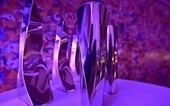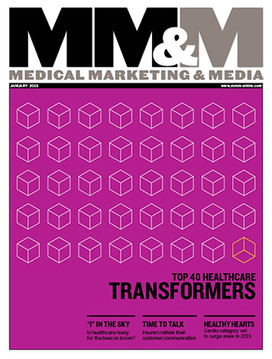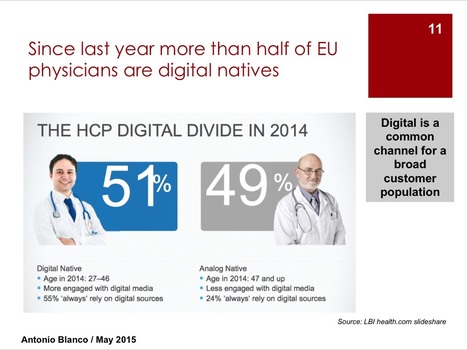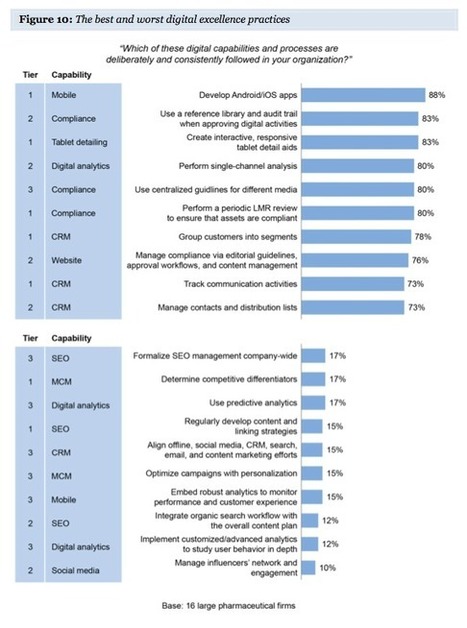 Your new post is loading...
 Your new post is loading...

|
Scooped by
Rémy TESTON
June 30, 2015 1:51 PM
|
Les géants de la pharmacie et du numérique ne se sont pas seulement associés dans un projet de lentille intelligente pour le suivi du diabète. Novartis et Google planchent également – et très discrètement – sur deux autres projets bien avancés, a révélé le laboratoire suisse à l’occasion de ses journées dédiées à l’innovation.

|
Rescooped by
Rémy TESTON
from Digital Health
June 17, 2015 2:15 AM
|
There can be no better insight into Pharma’s digital ambition than building a digital agency from scratch with pharmaceutical companies as the core client base. I have been working in pharma my whole career (now some 16 years) and feel very fortunate to have been around at a time of unprecedented change as technology has fundamentally impacted all aspects of the pharmaceutical business; from drug discovery and clinical trial development, through to the very nature of the product as health technology builds an evidence base and the focus moves from illness to wellness. Having spent the last two years building The EarthWorks I have reflected on how great the impact of digital health has had on pharma companies. When I look at what The EarthWorks are asked to do the strategic direction becomes clear. Over 70% of our output is in health technology design and build. Principally this is focussed on clinically impactful support for patients, however there is also a significant proportion of this work focussed on supporting healthcare professionals - with the best work providing integration and a symmetry between the two. When I first became a marketing manager in a pharmaceutical company, the vast majority of the focus and budget was on marketing materials. This is still an important part of what pharma does but the investment and the excitement seems to have irrevocably shifted. This got me thinking about how the digital health movement has impacted pharma. There are a great number of examples, including redefining real world data and challenging the nature of the communication between pharmaceutical companies and healthcare professionals. However I think there are two principle pressures stemming from the rise of digital health that is impacting pharma in 2015:
Via Alex Butler

|
Scooped by
Rémy TESTON
June 15, 2015 3:57 PM
|
Le laboratoire Boehringer Ingelheim vient de lancer l'appel à projets « Pulsaction » dont l’objectif est de soutenir 2 projets sur 17 régions en France, qui permettront d’améliorer le parcours de soins des patients souffrant de Fibrillation Atriale (FA) et traités par Anticoagulant Oral Direct (AOD).

|
Scooped by
Rémy TESTON
June 13, 2015 1:41 AM
|
Le groupe pharmaceutique a présenté sa stratégie d'open innovation lors de l'ouverture de Futur en Seine, à Paris. Il collabore déjà avec une dizaine de start-up françaises, notamment pour bâtir des applications mobiles liées à la prévention ou au soin. Une charte de bonnes relations est en cours de rédaction.

|
Scooped by
Rémy TESTON
June 7, 2015 7:48 AM
|
Bertalan Mesko highlights some of the key trends that are set to change our approach to health and wellbeing – and the way pharma does business. It's fascinating to witness how disruptive innovations can truly change the way healthcare is delivered...
Digital Marketing within the Pharma Industry: The first and safer way is to summarize the past 12 months, the second, more dangerous but also more exciting is …
Via eMedToday

|
Rescooped by
Rémy TESTON
from Social Media and Healthcare
June 1, 2015 2:58 AM
|
Earlier this month, Julie Papanek of Canaan Partners spoke with the Wall Street Journal about the changing needs of the pharmaceutical industry. She mentioned: How pharma’s traditional physician marketing model is breaking down because many major health systems aren’t allowing sales reps in the door The push for drug firms to prove their products actually benefit patients — especially in the real world The need to develop better technology solutions that help optimize promotion on social media now that the FDA has provided clarity on how drug firms can advertise via this channel The Wall Street Journal suggests that entrepreneurs and innovators are not paying enough attention to the growing and pressing needs of pharmaceutical companies in the digital health arena. But is this really the case? Yes and no. Yes, more innovations are needed. But it’s primarily a matter of aligning product market fit than the need to produce a lot more solutions. And, no, innovators are not ignoring Big Pharma, they’re scrambling to get in the door (more on this below). The key to digital health success in pharma will be about understanding the unique and changing needs of the industry and developing solutions — sometimes via a process of co-creation — that work well for drug firms. Let’s take another look at the industry’s needs. As Papanek mentioned, marketing and clinical data collection and mining are two. Additional areas of greatest need include: Strategic and organizational support to determine the best ways to commercialize existing assets and competencies in diagnostics, genetics, Big Data and more Development of a digital health pipeline that will accelerate the introduction of profitable and scalable products and services that will boost brand loyalty, replace a portion of lost revenue due to expiring patents, etc. Technology won’t meet all these needs. People with specialized knowledge and an innovative mindset will also play a big role. There are other factors at play. I spend a lot of time looking closely at investment data, keeping track of global digital health innovations and communicating with pharma executives about their needs in health tech. This work has taught me that: Pharmaceutical executives are flooded with digital health opportunities: Many startups and established companies are coming to drug firms with a range of innovations, from mobile health solutions to smart pills. Executives and leaders at these firms are having trouble triaging these innovations to determine which ones will meet key organizational, business and health goals.Drug firms are starting to turn to companies with multiple products and services for help: For example, earlier this year Qualcomm announced a number of deals with pharmaceutical companies to provide key digital health services and support technology innovations via venture funding.Companies are working hard to drive digital health innovation from within: A number of firms have created internal innovation groups that are responsible for locating, developing and supporting the integration of digital health technologies into their operations. There is a special need for this work in developing countries like Brazil and China. Overall, the digital health innovation picture in Big Pharma is a lot brighter than the headlines would have you believe. But, there’s clearly a lot more work to be done. The next few years are going to be very interesting.
Via Plus91

|
Rescooped by
Rémy TESTON
from Pharma Hub
May 28, 2015 1:23 PM
|
Novartis is collaborating with Rani Therapeutics, a US start-up in an endeavour to produce a so-called ‘robotic pill’ enabling a convenient administration of complex biotech drugs that are otherwise, normally given by injection. Rani’s capsule looks very much like a conventional pill, and is swallowed in the same way. However, the underlying mechanism of action differs in that the pill contains tiny needles made of sugar that are pushed into the wall of the intestine to deliver the drug.
Via Philippe Marchal

|
Scooped by
Rémy TESTON
May 19, 2015 6:38 AM
|
Les Français sont réticents à partager leurs données de santé dès lors que cet échange d’information s’effectuerait avec des acteurs économiques comme les laboratoires pharmaceutiques. Ils ne sont ...

|
Rescooped by
Rémy TESTON
from Pharma & Medical Devices
May 3, 2015 5:16 AM
|
A deep dive by the think tank Center for Talent Innovation indicates pharma and payers need to widen their definition of health when communicating with women.
Via Richard Meyer

|
Rescooped by
Rémy TESTON
from Social Media and Healthcare
April 27, 2015 12:47 PM
|
Ranking the digital competence of pharmaceutical brands
Via Plus91

|
Scooped by
Rémy TESTON
April 24, 2015 10:47 AM
|
En plus des essais cliniques, les laboratoires Roche vont manipuler des données retraçant les effets de ses molécules sur la durée.

|
Scooped by
Rémy TESTON
April 19, 2015 3:41 AM
|
Boston-based patient network PatientsLikeMe announced two pieces of pharma news this week: a five-year research collaboration deal with AstraZeneca and the results of a multiple sclerosis wearable study conducted in collaboration with Biogen.
The PatientsLikeMe-AstraZeneca deal is similar to one the company struck with Genentech last Spring. AstraZeneca will have full access to PatientsLikeMe’s global network, and the company will use the data to shape future medicine development and work to improve outcomes in different therapeutic areas, with an initial focus on respiratory disease, lupus, diabetes and oncology.
|

|
Scooped by
Rémy TESTON
June 20, 2015 2:46 AM
|
A digital strategy is important for Pharma to remain relevant. The need to connect with both patients and providers via digital formats and via mobile devices has been dictated by the successful penetration of these types of marketing, educational, and engagement tools in other aspects of our daily lives. Healthcare providers expect this evolution in the workplace as well.

|
Rescooped by
Rémy TESTON
from Social Media and Healthcare
June 17, 2015 2:13 AM
|
New report by Ogilvy Healthworld highlights who leads the way in integrated social media marketing
Key findings from the report: The average number of tweets by pharma has gone up by 530% since 2013 and twitter followers have increased by nearly 300%The pharma companies with the biggest communities aren’t necessarily the most effective at engaging with their users and generating interestFollowers reward pharma companies who post frequently and engage continuously – those that keep their networks fresh with regular updates have the highest interaction from the community LONDON, UK — Pharma’s corporate participation in social media is rapidly evolving, according to a new report published today by Ogilvy Healthworld, part of Ogilvy CommonHealth Worldwide, the health behaviour specialists of Ogilvy. The report “Connecting the dots: Which Pharma Companies are Succeeding in the Social Media Space?,” is the first of its kind to provide insights into which pharma companies are leading the way in integrated social media marketing strategies.
The report reveals a small group of companies are ‘connecting the dots’ and leading the way in social media. They are providing useful content that is both relevant to their marketing objectives and audience needs. They are engaging with consumers, healthcare professionals and media consistently on all of their networks in a way that encourages followers to contribute to the conversation.
The report also draws some conclusions on social media best practice. To succeed, pharma companies need to be brave and prepared to have honest and meaningful conversations about their brands. This involves developing strategies and mapping out potential scenarios with internal stakeholders to respond as quickly as possible to their followers. They should aim to provide content that is relevant to their audience also have a clear set of engagement guidelines to help manage difficult questions.
“We know that some pharma companies have been cautious in their approach to social media, but our report clearly demonstrates a dramatic and successful increase in activity,” said Rebecca Canvin, Social Media Manager at Ogilvy Healthworld, adding: “social media has changed the way pharma companies communicate – it allows them to build corporate reputation and engage in genuine, meaningful conversations with audiences. For companies who want to stand out from the crowd it’s time to be brave, get personal, educate and integrate social media into their wider marketing strategy.”
The data for the report was gathered by monitoring 10 of the most popular networks for 14 pharma companies across six categories: social presence, social network, community size, activity, engagement and activity. The profile of each company was reviewed for one week per month for three months during 2014 to ensure sufficient data was collected.
To find out more, please visit: http://bit.ly/1P5R5Ws
Methodology
This is Ogilvy Healthworld’s second pharma social media audit to analyse the corporate social media activity of 14 pharma companies. Ogilvy Healthworld analysed the profile of each company across 10 of the most popular social networks, reviewing one week of their social media activity per month for May, July and September in 2014. Six categories were analysed: Social presence - How many social networks was the company on?Social network - How simple and intuitive was the connection between social networks?Community size - How big was the community?Activity - Was the content kept fresh with regular updates?Engagement - Were the companies engaging their users and generating interest?Virality - Was the content spread around the social sphere?
Via Plus91

|
Scooped by
Rémy TESTON
June 15, 2015 3:54 PM
|
C’est en 1997 que Clayton Christensen de la Harvard Business School introduisit pour la première fois le terme de « disruptive innovation » ou innovation de rupture, par opposition au processus d’innovation traditionnelle.

|
Rescooped by
Rémy TESTON
from Pharma Hub
June 12, 2015 3:10 AM
|
Le laboratoire Sanofi a élaboré une stratégie d'innovation en matière de santé connectée qui s'appuie sur l'"agilité" de start-up, a expliqué Gilles Litman, directeur stratégie et innovation de Sanofi France, jeudi lors d'un point presse réalisé à l'occasion du festival Futur en Seine.
Via Philippe Marchal

|
Rescooped by
Rémy TESTON
from Pharmabook
June 6, 2015 3:51 AM
|
SOURCE June 4, 2015 Bertalan Mesko highlights some of the key trends that are set to change our approach to health and wellbeing – and the way pharma does business. It's fascinating to witness how disruptive innovations can truly change the way healthcare is delivered and medicine is practised. Enormous technological changes are heading our way. However, if they hit us unprepared – which we are now – they will wash away the medical system we know and leave it purely a technology-based se
Via Philippe Loizon

|
Rescooped by
Rémy TESTON
from Social Media and Healthcare
June 2, 2015 4:58 PM
|
Ranking the digital competence of pharmaceutical brands
Via Plus91

|
Rescooped by
Rémy TESTON
from Pharma Hub
May 31, 2015 1:39 PM
|
Individual pharma companies, digital/multichannel, brand, marketing and medical teams can safely assume that most HCPs are now digital natives and by 2020, two thirds will be so* This topic formed the focus of several presentations delivered this month in Rome at EXL's @DigitalPharma Europe conference, as demonstrated in the slide below from Antonio Blanco, Area Sales Lead, Astrazeneca. *Source: LBI Health: www.lbi.com/uk
Via Philippe Marchal

|
Rescooped by
Rémy TESTON
from Social Media and Healthcare
May 26, 2015 2:55 PM
|
How can the pharma and healthcare industry thrill on social media?
“The next time you hear a social media myth, question it. Ask for the proof and ask out loud” – Dan Zarrella, social media scientist Pharma – a highly regulated industry – has been notoriously slow at taking up social media. It’s not surprising when the rules for how they can and can’t use social media are prohibitively vague. But over the past few years the myth that pharma companies can’t use social media has been unravelled and conversations now focus on ‘how can pharma do social?’ This movement brings about unique challenges, but one thing is for certain – as more companies recognise the importance of social media it’s time for pharma to be brave and take their conversations to the next level. What does being brave look like in pharma?
Bravery comes in many shapes and forms and what may be seen as basic social media practice in other industries can be courageous in the pharma industry. While brands like Innocent and Oreo are able to push boundaries by responding to online trends within a matter of seconds, or delivering distinctive and humorous content, pharma is somewhat conservative due to navigating regulatory rules. But this doesn’t mean that pharma companies should hold back - having a social media strategy is more important than ever in order to connect with audiences. Back to basics
So how can pharma begin to stand out from the crowd? And what benefit will this bring? Firstly it’s important to get the basics right. By having online conversations and engaging appropriately instead of just pushing out content on social networks, companies can build trust and respect from their followers. Johnson & Johnson do this well by engaging with consumers, healthcare professionals and media consistently on their networks in a way that encourages followers to contribute to the conversation. Another way that pharmaceutical businesses can participate in social media is to move fast when they receive comments online. To do this effectively all stakeholders need to be prepared and scenarios need to be planned for like Boehringer Ingelheim, who responds to comments quickly and effectively. Pharma companies should also use platforms effectively and provide their audiences with informative and educational content. Bayer HealthCare provides followers with useful and relevant content,which means their content is shared far and wide. Learning from non-profit health campaigns no-friends-2.jpg For those companies who have already established a successful social media presence, it’s time to step it up a notch. This may take greater investment of time and energy but it doesn’t mean that pharma can’t be courageous. Pharma can learn from campaigns by others in the healthcare space/arena, such as the [Columbian League Against Cancer Cancer tweets that spread out virtual cancer through Twitter and the recent Age UK 'No Friends' (above) that responded to Facebook’s 'Friends' campaign with posters highlighting loneliness among older people. These campaigns were successful because they were brave, emotive and raised awareness of important health issues – loneliness and cancer. By taking key learnings from these creative campaigns pharma can produce exciting content that really resonates with their audiences. Strong foundations
The shift in social media involvement by pharma companies over the past few years to understand the benefits that it can bring is a good start, but pharmacompanies now need to ensure they are getting the basics right to form the foundations of their social media strategy. These strong foundations enable them to begin to stretch the limits and gain recognition for their efforts. Without this investment in a social future, the pharmaceutical industry is in danger of getting left behind.
Via Plus91
Pharmaceutical firms must adopt and consistently execute practices that lead to digital excellence and give them a competitive edge. Which of these firms are accelerating away from the rest of the marketplace? We found that only two—Merck and Bristol-Myers Squibb—are doing reasonably well and achieving excellence and maturity in their digital capability. Firms taking a disciplined approach to digital transformation achieved higher maturity in digital capability than their less-disciplined peers.
Via Lionel Reichardt / le Pharmageek

|
Rescooped by
Rémy TESTON
from Social Media and Healthcare
May 1, 2015 2:25 AM
|
Social media platforms refer to the interaction among the people that involves creation, sharing and exchange of information and ideas in virtual networks and communities. However, use of these social media tools for marketing pharma content is still debatable. The rationale behind this is that the regulatory teams of several pharma companies demand the preventionof comments or sharing features resulting in only a one way interaction,which in turn deprives theessence of social media marketing. However, with the impact of these tools, there is an increased adoption rate of these platforms for strategic decisions. Efforts of pharma sector to leverage the benefits of social media tools to widen their customer base, strengthen customer relationship and enhance brand performance further fuels the usage of social media pharma and healthcare marketing. Other major aspects favorable for pharma sector are building investor relations, corporate communication and customer service at the corporate level. The involvement of regulatory authorities in drafting and issuing guidance for use of interactive media for drugs and biologics proves to be instrumental in deciding the importance of social media marketing in pharma industry. For instance,in second week of January 2014, the U.S. Food and Drug Administration (FDA) released a guidance draft for industry that needs to fulfill the regulatory requirements for post marketing submissions of interactive promotional media for animal and human drugs and biologics. Through this draft, the US-FDA provided clarity on working with bloggers and content creators to disseminate branded information. Incorporation of consumer feedback and their experiences would prove decisive for the companies in the course of novel drug development and other crucial strategy building. Hence social media involvements are further expected to increase product sales in the near future. For instance, Novartis has initiated the use of social media platforms to enhance the sales of its over-the-counter drugs such as Comtrax, Bufferin and Orofar. Another illustration for the use of these social media platforms is by Johnson & Johnson that uses these platforms for crisis management during recall of its products. It has used these social media platforms for apologizing to the consumers for irregularities found in its manufacturing plant by U.S. FDA. It is company’s mode of being personally, emotionally and socially in touch with its clients. The pharma and healthcare social media market can be analyzed by the extent of use of social media platforms such as Twitter, YouTube, etc. by pharma industries along with benefit and risk ratio analysis of these tools in healthcare. In addition, impact or effect of these tools on healthcare stakeholders such as hospitals, patients/consumers, healthcare professionals and biotechnology companies coupled with a geographical landscape focusing on the popularity of these tools also can be provided. The geographical landscape includes the analysis of four major regions namely North America, Asia-Pacific, Europe and RoW. The major factors favoring the growth of the market are increased expenditure by pharmaceutical companies for online advertising along with increasing adoption rates of online marketing tools by the consumers. As per few research studies in the year 2012, the overall pharmaceutical and healthcare spending increased nearly by 45 percent year-on-year to approximately USD 1.1billion of which 6 percent represented online advertising costs. This revenue is generated through paid advertisements and subscriptions from various electronic devices and unique IP addresses. On the other hand, the disadvantages and risk factors of these platforms such as privacy and security in question along with improper content validation are some of the issues that might pose the challenge for the growth of the market. Some of the companies engaged in use of social media are Johnson & Johnson, Novo Nordisk, Pfizer, Inc., Novartis and Bayer AG.
Via Plus91

|
Scooped by
Rémy TESTON
April 26, 2015 3:21 AM
|
For the full report, please email pharmasocial@ogilvy.com

|
Scooped by
Rémy TESTON
April 21, 2015 9:02 AM
|
Gilles Litman explique pour La Tribune comment le premier groupe pharmaceutique français veut développer une véritable stratégie e-santé pour compléter son offre médicamenteuse et auréoler son image d'une forte composante 2.0.
|



 Your new post is loading...
Your new post is loading...



































